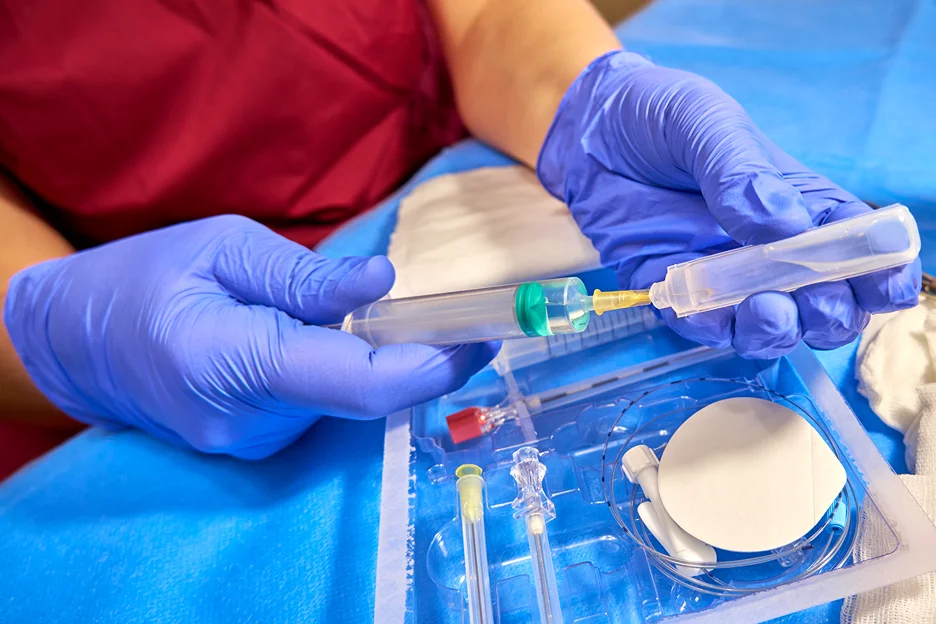Living with chronic back pain is debilitating and can greatly reduce one’s quality of life.
While many treatment options exist, one potential solution that is growing in popularity is the epidural injection. But what exactly is an epidural and how can it help alleviate back pain?
In this guide, we will explore everything you need to know about epidural steroid injections for back pain relief.
What is an epidural spinal steroid injection?
An epidural steroid injection delivers corticosteroid medication and anesthetic into the epidural space surrounding the spinal cord to reduce inflammation around spinal nerves and temporarily numb pain receptors. This can provide relief from back pain caused by herniated discs, spinal stenosis, pinched nerves and other conditions.
How does an epidural steroid injection help with back pain?
Epidural steroid injections are thought to help alleviate back pain in several ways:
- The corticosteroid medication reduces inflammation around the spinal nerves, caused by conditions like bulging or herniated discs, spinal stenosis, or arthritis.
- The anesthetic numbs painful nerves, blocking the transmission of pain signals to the brain.
- The reduction in inflammation and pain input allows the body to gradually heal, the back muscles to relax, and normal movement to be restored.
- Physical therapy and rehabilitative exercises can be resumed more easily without severe pain, thus facilitating long-term improvement.
While not a cure, epidural steroid injections can break the cycle of inflammation and muscle spasm that underlies many chronic back pain conditions. The pain relief facilitates a return to normal activity and healing.
What are shots for back pain?
There are several types of therapeutic injections that can help alleviate back pain:
- Epidural steroid injections, or ESIs, are the most common. These deliver anti-inflammatory corticosteroid into the epidural space surrounding inflamed spinal nerves.
- Facet joint injections target the facet joints between vertebrae. Steroids help reduce inflammation in arthritic joints.
- Selective nerve root blocks deliver anesthetic to a specific irritated nerve. This temporarily interrupts pain signal transmission along that nerve.
- Trigger point injections inject anesthetic directly into knots of muscle. This provides relief from myofascial tightness and spasm.
Most back pain injections combine a corticosteroid to reduce inflammation and an anesthetic to numb pain.
| Type of Injection | Medication Used | Mechanism | Appropriate Conditions |
| Epidural steroid | Corticosteroid + anesthetic | Reduce inflammation around nerves, numb nerves | Herniated discs, spinal stenosis, radiculopathy |
| Facet joint | Corticosteroid + anesthetic | Reduce inflammation in joints, numb joints | Facet joint arthritis |
| Nerve root block | Anesthetic | Interrupt pain signals along nerve | Pinched/inflamed nerve |
| Trigger point | Anesthetic | Numb tight muscle knots | Myofascial tightness and spasm |
How does a back pain injection work?

Back pain injections work by targeted delivery of medication to provide localized effects: epidural steroid injections reduce inflammation around nerves; facet joint injections treat arthritic joints; nerve blocks numb irritated nerves; trigger point injections relax muscle knots; prolotherapy stimulates healing of damaged tissues. This disrupts the pain/inflammation cycle, allowing gradual healing and symptom relief.
How effective are back injections for back pain?
The effectiveness of back pain injections depends on the type performed and the underlying cause of pain:
- For radicular nerve-related back pain, epidural steroid injections provide significant relief in a majority of patients, though the duration of relief varies.
- Facet joint injections are effective for a large number of patients with facet joint arthritis. But the pain relief tends to be short-lived, averaging 7-10 weeks.
- Selective nerve root blocks provide rapid pain relief by numbing the irritated nerve, though the effects wear off as the anesthetic is metabolized.
- Trigger point injections can immediately resolve myofascial tightness and spasm, but repeated injections are often required
No injection provides permanent relief. But by quieting pain and inflammation during flare ups, shots for back pain facilitate rehabilitation exercises and allow the natural healing process to occur. Most patients experience significant relief for weeks to months following targeted back injections.
How effective is an epidural steroid injection for back pain?
Epidural steroid injections effectively relieve back pain in about 75% of patients within 2 weeks, though benefits are often temporary, lasting months to a year. Effectiveness depends on the cause of pain but allows patients to remain active during peak relief, facilitating natural healing processes when combined with physical therapy.
Why is my back sore after an epidural injection?
It is very common for patients to experience back soreness and achiness for 1-2 days after receiving an epidural steroid injection. Reasons for this include:
- Inserting the needle into the epidural space can cause local trauma and irritation. Inflammation results as the tissues heal, provoking pain.
- The corticosteroid itself may elicit a flushing reaction, contributing to feelings of warmth and soreness.
- Once the anesthetic wears off, cramping and tightening of the back muscles often occurs, adding to discomfort.
- Rarely, more serious complications like infection or bleeding can occur, leading to worsening soreness.
The good news is post-epidural back soreness is usually mild, localized, and temporary. While bothersome, it is a normal part of the recovery process after an injection. Staying well hydrated, using ice/heat, and taking OTC medication can help soothe the discomfort as it gradually resolves.
Are there any side effects of epidural steroid injections?
Epidural steroid injections are generally very safe when administered by an experienced provider. However, there are some potential side effects to be aware of:
- Temporary side effects like headache, nausea, facial flushing, and dizziness are relatively common but not serious. These usually resolve within hours or days after the injection.
- There are small risks of bleeding and infection at the injection site. But serious complications are very rare, estimated at less than 1%. Proper sterile technique minimizes these risks.
- There is a risk of nerve damage if the needle is inadvertently inserted into the spinal cord rather than the epidural space. But this is extremely uncommon with an experienced doctor.
- Repeated epidural injections over time can lead to bone density loss and osteoporosis. However, this risk is small when spacing injections at least 3 months apart.
Can an epidural shot provide relief from back pain?
Yes, epidural steroid injections have been shown to provide considerable relief from back pain in many patients. However, there are some important caveats:
- The degree of pain relief varies based on the cause and severity of pain. Disc herniations often respond very well initially, while spinal stenosis sees more modest improvements.
- Onset of pain relief begins within 1-2 weeks in most patients and provides substantial reductions in pain for some period of time.
- The duration of pain relief is limited however, averaging around 13 weeks. Repeat injections are commonly needed, sometimes at progressively shorter intervals.
- ESI provides temporary back pain relief but does not address the underlying condition. Ongoing physical therapy and treatment is important for long term results.
- There are small risks like infection and bleeding to consider as well. However, serious complications are rare when ESIs are administered properly.
For the right back pain conditions, epidural steroid injections can provide much needed relief during flare ups and allow time for healing. But expectations must remain realistic, and an integrated approach is key.
Why Choose Kaly MD

With extensive training and years of experience, our pain specialists are experts at administering epidural injections. Using precision imaging guidance, we are able to place the medication right where it’s needed most with minimal discomfort.
Kaly MD also takes a holistic approach to back pain treatment. We create customized plans that combine epidural injections as needed with physical therapy, massage, rest, medication, diet changes, and stress management.
